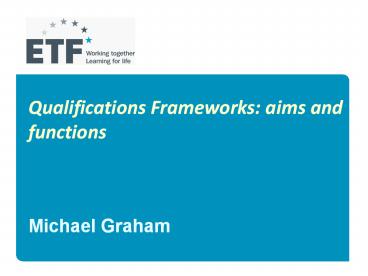Qualifications Frameworks: aims and functions Michael Graham - PowerPoint PPT Presentation
1 / 12
Title:
Qualifications Frameworks: aims and functions Michael Graham
Description:
... Azerbaijan, Belarus, Georgia, Republic of Moldova, Ukraine And ... Morocco, ENP East and Russia: Armenia, Azerbaijan, Belarus, Georgia, Republic of Moldova, ... – PowerPoint PPT presentation
Number of Views:96
Avg rating:3.0/5.0
Title: Qualifications Frameworks: aims and functions Michael Graham
1
Qualifications Frameworks aims and
functionsMichael Graham
2
30 ETF partner countries
Potential candidate countries Albania, Bosnia
-Herzegovina, Kosovo, Montenegro, Serbia
3
24 countries developing NQFs
Potential candidate countries Albania, Bosnia
-Herzegovina, Kosovo, Montenegro, Serbia
4
ETF activities in the field of qualifications
- Operations in partner countries support to
partner countries in exploring the relevance of
NQF as tool for reform, facilitation of the
design phase - Studies research on NQFs development,
inventories - Linking EU policies to agenda in partner
countries - Increasingly focus is on building capacities for
implementation, and assisting countries to be in
control of their reforms in order to ensure
sustainable results
5
ETF work with partner countries in 2011
- Country- specific activities in 16 countries
- Albania, Algeria, Azerbaijan, Bosnia and
Herzegovina, Croatia, Egypt, Georgia, Kosovo,
Lebanon, Morocco, Occupied Palestinian Territory,
Republic of Moldova, Russia, Serbia, Turkey,
Ukraine - Regional projects
- Pre-accession region Post2ndary VET Mutual
Learning EQF Conference Budapest - Eastern Partnership Transparency within Lifelong
Learning project - Mediterranean Regional dimension of
qualifications Social Partnership - Corporate activities
- Qualifications Platform Oct 2011 international
conference implementing qualifications frameworks
6
Why Qualifications?
- Education and training are important for social
inclusion, employment and economic development - Quality is linked to relevance
- - Qualifications showing what people are able to
do (learning outcomes) - So that qualifications are trusted on the labour
market and open possibilities for further
learning
7
Why Qualifications Frameworks?
- Classification of qualifications not new.
- But bringing together qualifications from
different sectors into one system - is new - Creating better linkages between qualifications
systems- e.g. HE to VET - making qualifications
comparable - But also bringing together different stakeholders
involved in the design and delivery of
qualifications - Strengthening the role of representatives from
the world of work and social partners - Link E and T to labour markets universal aim in
our partner countries.
8
Why Qualifications Frameworks?
- NQFs contribute to LLL by
- - putting learner at centre
- - improving access, progression and transfer
- - promoting cooperation between stakeholders
- EQF and other transnational QFs
9
QFs as a tool to improve qualifications systems
and qualifications
- Qualifications framework provide platform to
bring stakeholders into qualifications systems. - Qualifications Frameworks are framework of
qualifications the qualifications are central. - Reform is about the qualifications systems,
qualifications and qualifications frameworks
10
Findings from our work
- Countries develop QFs in context of new VET/HE
policies - NQFs seem most useful as a generic tool, linked
with other approaches - Not one model, NQFs are highly context and
capacity-dependent - Capacity building and policy learning are central
to our approach
11
Findings from our work
- Implementation about both technical and
social/institutional challenges - Impact depends also on quality of implementation
12
Kosovos NQF
- Integrating, lifelong learning
- Kosovo ahead of most of its neighbours (and some
EU Member States) - Linking to EQF and Bologna Process































